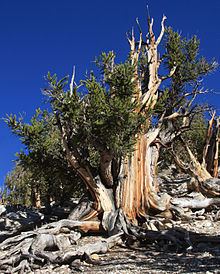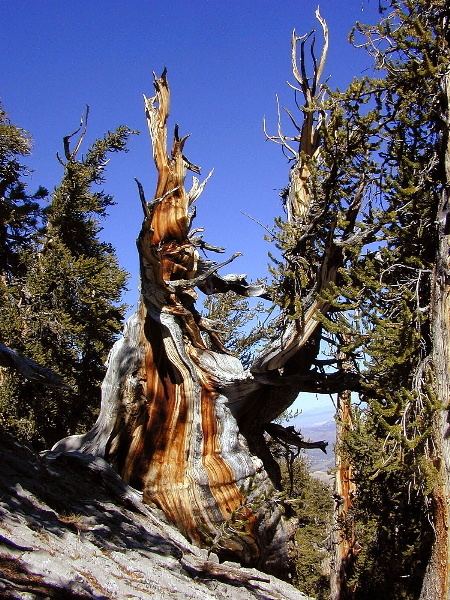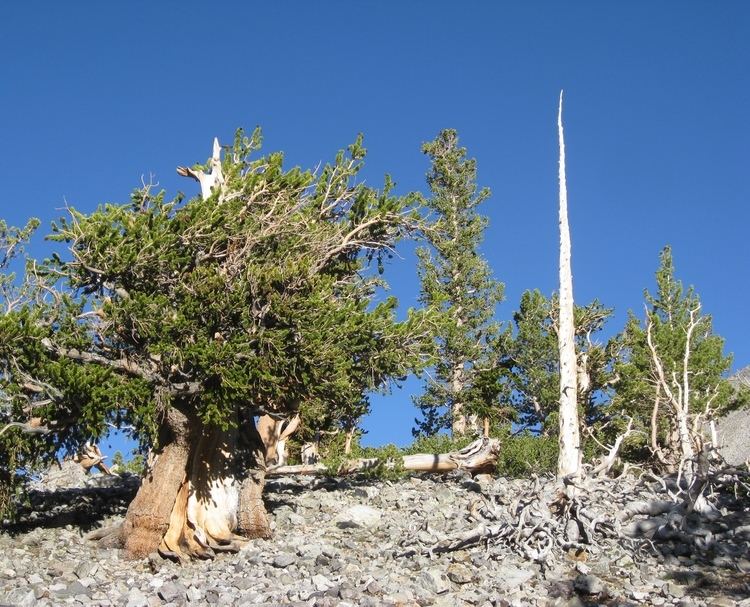Genus Pinus Scientific name Pinus longaeva Rank Species | Division Pinophyta Subgenus Pinus Higher classification Ducampopinus | |
 | ||
Similar Pine, Bristlecone pine, Pinus aristata, Pinus balfouriana, Conifers | ||
Pinus longaeva (commonly referred to as the Great Basin bristlecone pine, intermountain bristlecone pine, or western bristlecone pine) is a long-living species of bristlecone pine tree found in the higher mountains of California, Nevada, and Utah. One member of this species, at 5066 years old, is the oldest known living non-clonal organism on Earth. In 1987, the bristlecone pine was designated one of Nevada's state trees.
Contents

Physical characteristics

It is a medium-size tree, reaching 5 to 15 m (16 to 49 ft) tall and with a trunk diameter of up to 2.5 to 3.6 m (8 ft 2 in to 11 ft 10 in). The bark is bright orange-yellow, thin and scaly at the base of the trunk. The needles are in fascicles of five, stout, 2.5 to 4 cm (0.98 to 1.57 in) long, deep green to blue-green on the outer face, with stomata confined to a bright white band on the inner surfaces. The leaves show the longest persistence of any plant, with some remaining green for 45 years (Ewers & Schmid 1981).

These ancient trees have a gnarled and stunted appearance, especially those found at high altitudes, and have reddish-brown bark with deep fissures. As the tree ages, much of its vascular cambium layer may die. In very old specimens, often only a narrow strip of living tissue connects the roots to a handful of live branches.

The cones are ovoid-cylindrical, 5 to 10 cm (2.0 to 3.9 in) long and 3 to 4 cm (1.2 to 1.6 in) broad when closed, green or purple at first, ripening orange-buff when 16 months old, with numerous thin, fragile scales, each scale with a bristle-like spine 2 to 5 mm (0.079 to 0.197 in) long. The cones open to 4 to 6 cm (1.6 to 2.4 in) broad when mature, releasing the seeds immediately after opening. The seeds are 5 mm (0.20 in) long, with a 12 to 22 mm (0.47 to 0.87 in) wing; they are mostly dispersed by the wind, but some are also dispersed by Clark's nutcrackers.

The Great Basin bristlecone pine differs from the Rocky Mountain bristlecone pine in that the needles of the former always have two uninterrupted resin canals, so it lacks the characteristic small white resin flecks appearing on the needles of the latter. The Great Basin bristlecone pine differs from the foxtail pine because the cone bristles of the former are over 2 mm (0.079 in) long, and the cones have a more rounded (not conic) base. The green pine needles give the twisted branches a bottle-brush appearance. The name 'bristlecone pine' refers to the dark purple female cones that bear incurved prickles on their surface.
Distribution and ecology
The species occurs in Utah, Nevada and eastern California. In California, it is restricted to the White Mountains, the Inyo Mountains, and the Panamint Range, in Mono and Inyo counties. In Nevada, it is found in most of the higher ranges of the Basin and Range from the Spring Mountains near Las Vegas north to the Ruby Mountains, and in Utah, northeast to South Tent in the Wasatch Range.
The tree grows in large open stands, unlike the related foxtail pine, which sometimes form dense forests. Pinus longaeva trees generally don't form closed canopies, usually covering only 15-50%. Pinus longaeva shares habitats with a number of other pine species, including the ponderosa pine, the white fir and, notably, the limber pine, a similarly long-lived high-elevation species. The tree is a "vigorous" primary succession species, growing quickly on new open ground. It is a "poor competitor" in good soils, however, and the species does best in harsh terrain. Pinus longaeva is often the dominant species in high-elevation dolomite soils, where few plants can grow.
Bristlecone pines are protected in a number of areas owned by the United States federal government, such as the Ancient Bristlecone Pine Forest in the White Mountains of California and the Great Basin National Park in Nevada. These areas prohibit the cutting or gathering of wood.
Clark's nutcrackers pluck P. longaeva seeds out of the opening cones. The nutcrackers use the seeds as a food resource, storing many for later use in the ground, and some of these stored seeds are not used and are able to grow into new plants.
An introduced fungal disease known as white pine blister rust (Cronartium ribicola) is believed to affect some individuals. The species was placed on the IUCN Red List and listed as "Vulnerable", or threatened, in 1998. In 2011, however, a population survey found the population of Pinus longaeva to be stable, with no known subpopulations decreasing in size. White pine blister rust was found to have a negligible effect on the population. As a result, the species was moved to "Least Concern".
Fire ecology
The tree is extremely vulnerable to fire, and is damaged by even low-intensity burns. The resinous bark is capable of igniting quickly, and a crown fire will almost certainly kill the tree. However, populations of Pinus longaeva are known to be extremely resilient, and as a primary succession species, it is believed that populations of the tree would reestablish itself quickly after a fire. That said, large-scale fires are extremely uncommon where the species grows, and are not a major factor in the species' long-term viability.
Age
A specimen of this species, located in the White Mountains of California was measured by Tom Harlan, a researcher with the Laboratory of Tree-Ring Research, to be 5,062 years old in 2012. The identity of the specimen is being kept secret by Harlan. This is the oldest known tree in North America, and the oldest known individual tree in the world, although a clonal individual, nicknamed "Old Tjikko", a Norway spruce in Sweden is 9,550 years old.
The previously oldest named specimen of this species, "Methuselah", is also located in the Ancient Bristlecone Pine Forest of the White Mountains. Methuselah is 4,844 years old, as measured by annual ring count on a small core taken with an increment borer. Its exact location is also kept secret.
Among the White Mountain specimens, the oldest trees are found on north-facing slopes, with an average of 2,000 years, as compared to the 1,000 year average on the southern slopes. The climate and the durability of their wood can preserve them long after death, with dead trees as old as 7,000 years persisting next to live ones.
